José Efraín was my dear Mom’s uncle, my dear Grandpa Francisco’s brother.
A World War II Veteran, a modest, quiet man,
Who spoke a little about being in Iwo Jima and the war,
But never discussed much more,
I found out later, many medals he wore.
José was a sharpshooter in the famous 147th “Lost Regiment”
Who fought bravely in combat alongside Marines,
Won the war, and came home a real trooper
Who kept it all inside to deal with life,
Three kids and a loving wife.
For nintety-five years
José lived life to the brim, yet quiet and reserved,
Died in his sleep, a quiet farewell.
Went to meet his maker, his God,
A quiet hero we salute today, who did his duty well.
Just recently, I learned that according to my Mom’s first cousin, Javier Elizondo, his Tío José who was called “Pepe”, (nickname for José), during WWII, was coming onto an island with his regiment when he heard someone yell repeatedly, “Pepe!” Well in some far-away place, half way around the world from Laredo, who was calling him was non-other than his older brother, Margarito Elizondo! The two brothers hugged, laughed, and cried with each other!! I am assuming that after seeing the horrors of war, as they did, what a God-given blessing they both got!
Thank-you, Javier, for sharing that with me. I’m also interested in doing some research on my other Great-Uncle Margarito, my Grandfather Francisco’s other brother. So, please Javier, reach out to me with more WWWII information on where Tío Margarito served and other interesting info on him and his family.
————————————————————
This author did some research on the 147th, my Great-Uncle José Efraín was in, and found the following information, according to Google:
At the beginning of US involvement in World War II, the 147th became a “lost regiment” when it pulled out of the 37th Infantry Division to triangularize it in 1942. The regiment went to war in the South Pacific as an independent regiment, and fought in several battles alongside a greater number of United States Marine Corps troops. The 147th first engaged in combat during the Battle of Guadalcanal, where it took part in the assault on Mt. Austen.[2] During this battle, General Alexander Patch was forced to reorganize his forces due to combat losses, and created the CAM (Composite Army-Marine) Division, which consisted of the 147th Infantry Regiment, the 182nd Infantry Regiment, and the 6th Marine Regiment, along with artillery elements from the Americal Division and the 2nd Marine Division.[2] In early January 1943, I Company and a platoon of M Company cut off the Japanese escape routes along a 20-mile front while the CAM pushed the defenders back towards the western beach of Guadalcanal. Along the coast, the CAM Division began its attack at the same time with a three-regiment front: the 6th Marines on the beach, the 147th Infantry in the center, and the 182nd Infantry abreast of 25th Infantry Division on the left. Alternating the lead attack position, the 147th Infantry, the 182nd Infantry, and the 6th Marines progressed from one to three miles a day through weak resistance. By 8 February these units had reached Doma Cove, nine miles beyond the Poha River and the same distance short of Cape Esperance.[2] By 9 February 1943, the Americans had cleared the island, and the 147th moved on to its next assignment.
The regiment relieved the 4th Marines on Emirau Island[3] on 11 April 1944 and performed garrison duties until they were relieved by the 369th Infantry Regiment in June. While they were on Emirau, they assisted the US Navy Seabees in constructing an airfield, because the 147th was the only infantry regiment who’d constructed an airfield before (at Tonga in 1942). The regiment then moved to the island of Saipan in the wake of the first landings to conduct mopping up operations behind the 2nd Marine Division, the 4th Marine Division, and the 27th Infantry Division. The island was declared secure on 9 July 1944, but Japanese resistance continued for months afterward. The 147th next moved to the island of Tinian to follow elements of the 2nd and 4th Marine Divisions as they assaulted through the island. The 147th rooted out stubborn Japanese defenders and continued fighting after the island was officially declared secure on 1 August 1944.
The regiment’s next assignment would prove to be their most difficult; in the spring of 1945, the Ohioans fought in the Battle of Iwo Jima. In the early days of the Marine landings, the 147th was ordered to climb from landing craft with grappling hooks to scale a high ridge about 3/4 mile from Mount Suribachi. The mission was to fire on the enemy opposing the Marine landings on the beaches below.[4] They were soon pinned down by heavy Japanese fire, and engaged in non-stop fighting for 31 days. Once the island was declared secure, the regiment was ostensibly there to act as a garrison force, but they soon found themselves locked in a bitter struggle against thousands of stalwart defenders engaging in a last-ditch guerilla campaign to harass the Americans.[5] Using well-supplied caves and tunnel systems, the Japanese resisted American advances. For three months, the 147th slogged across the island, using flamethrowers, grenades, and satchel charges to dig out the enemy. Some sources credit the regiment with killing at least 6,000 Japanese soldiers in those anonymous and merciless small unit actions.[5] The 147th would go on to fight in the bloody Battle of Okinawa, once again in charge of rooting out stubborn Japanese defenders who remained even after the island was declared secure. Company D, which remained on the island of Tinian, earned the distinction of transporting and guarding the Little Boy atomic bomb.[6] When the war ended on 2 September 1945, the 147th Infantry was sent home piecemeal, and the last men to return home arrived in March 1946.[4]
During World War II, the 147th Infantry Regiment fought in the infamous battles of Guadalcanal, Saipan, Tinian, Iwo Jima, and Okinawa. These battles are often associated with the US Marines, but no US unit other than the 147th fought in all of these battles.
Until I see you again, my Dear Uncle José Efraín Elizondo, I salute your bravery!
Bobby Collazo, 9/16/2019 & Updated 02/08/2022
www.robertcollazojr.com
Below, a young José Efraín
Photo below, Elizondo Brothers (Left to Right seated), Matias, Margarito, Polo, and in back, my Grandfather Francisco
Photo below, Polo, Lile, Margarito, Mamá Goya’s sister, Carmen & her husband, Ernesto DeLaChica 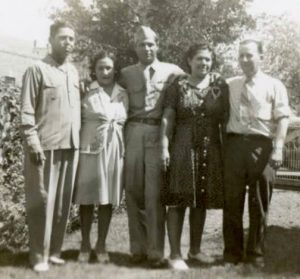
Photo below with a young Matias and Gregoria Elizondo with their sons.
Photo below of Aurora & Margarito Elizondo on their wedding day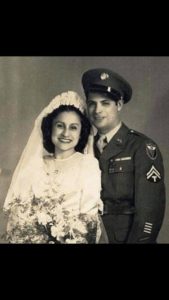
Photo below of Bobby Collazo with Tío Efrain & Grace with Ernesto (Neto) Elizondo, Jr.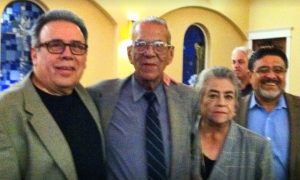
Below, my dear Mom’s first Cousin, Javier Elizondo, Sr. Again, Thanks much, Javier, for all the Elizondo information you’ve given me. And, of course, your love & warm-hearted words are priceless to me. Stay well, love you.
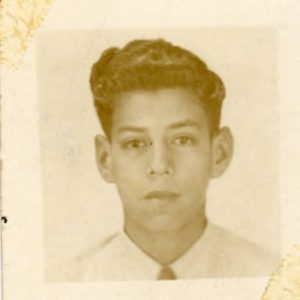
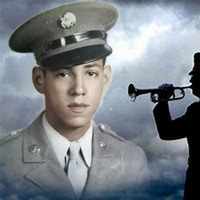
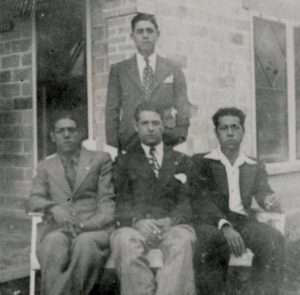
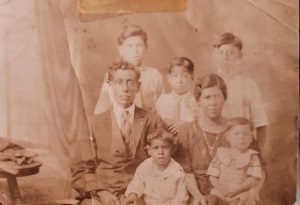
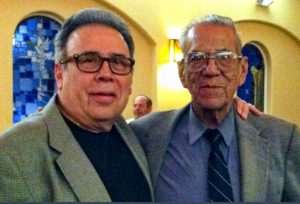
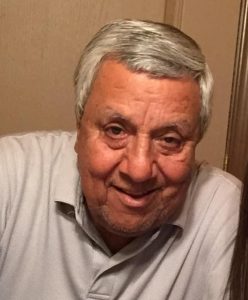

Thanks for posting my photo, Bobby. I’m just sorry that I don’t have anymore information on Tío Mague.
Unfortunately all his family, Aurora (wife), Mague Jr., Estela, and Robert, died and took his history. I can tell you this, Tio Mague was most handsome of all the brothers! He was a jovial and understanding and laughed at his own joes, sometimes unable to finish the jokes laughing.
I can also tell you, when I was a little kid, I went with my Dad to help in the building of his home! That’s one thing about the Elizondos’, they stuck together like gorilla glue.
All the brothers got together after work and on weekends to build their own homes! Both house are still standing.
Tio Matias was the best carpenter and supervisor. I don’t know much of his house they built initially but I do remember all of them working on an addition to his house.
Always after they stopped their work, while enjoying my coke, I loved listening to them talking and drinking their beer. I miss all of them.